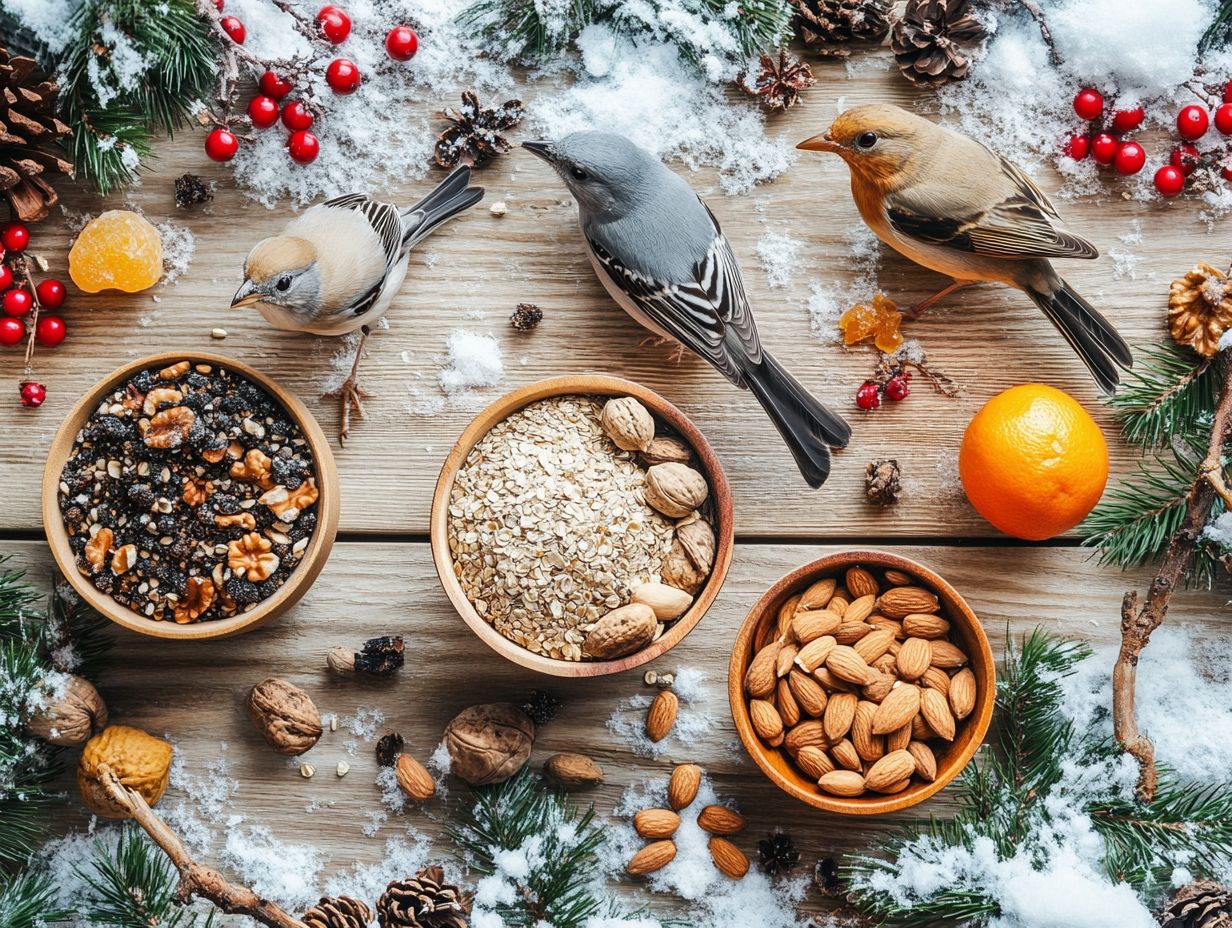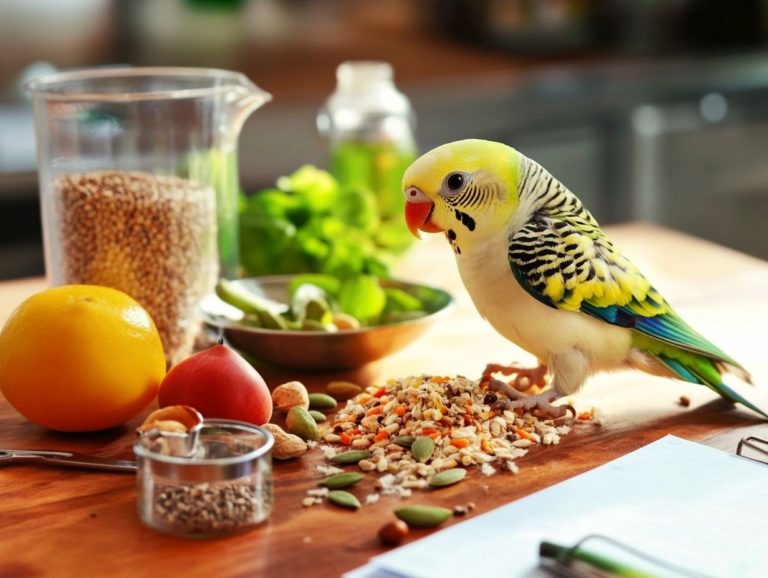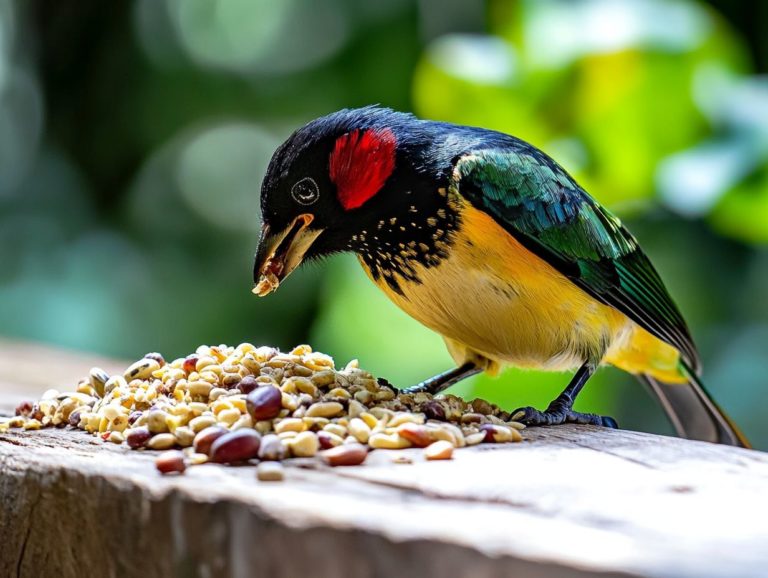The Best Bird Food Options for Winter
As winter’s chill descends, many bird species encounter a formidable landscape for survival. Understanding the significance of winter bird feeding can transform your backyard into a sanctuary for these resilient creatures.
With the right selection of bird food think seeds, nuts, and suet along with tips for creating a welcoming environment and overcoming common challenges, this guide empowers you to attract and support our feathered friends throughout the colder months.
Explore how you can make a meaningful impact in their lives while reveling in the beauty of winter birdwatching.
Contents
- Key Takeaways:
- Understanding Winter Bird Feeding
- Types of Bird Food
- How to Choose the Best Bird Food for Winter
- Attracting Birds to Your Yard
- Feeding Tips for Winter Birds
- Dealing with Common Issues
- Frequently Asked Questions
- What are the best bird food options for winter?
- Why are these bird food options considered the best for winter?
- Can I feed birds the same food in winter as I do in other seasons?
- Are there any bird food options I should avoid in winter?
- Do different bird species have different food preferences for winter?
- Can I make my own bird food for winter?
Key Takeaways:

- Winter feeding is vital for bird survival.
- Offer a mix of seeds, suet, and fruits to attract various species.
- Keep feeders tidy and adjust food levels based on the weather for their safety.
Understanding Winter Bird Feeding
Understanding winter bird feeding is essential for anyone passionate about attracting and supporting a diverse array of backyard birds. This knowledge enables you to provide food and create shelter, ensuring these birds can thrive.
As a bird feeding enthusiast, you play an important part in this process. Adopt various ways to feed birds tailored to accommodate different species, especially when snow blankets their natural food sources.
Why Winter Feeding is Important
Feeding winter birds is essential, especially when natural food sources dwindle during the cold months. Help our feathered friends survive the winter by providing food consistently.
In winter, many birds face challenges in finding adequate nutrition. Snow-covered ground and frozen water sources lead to increased mortality rates. Bird feeders serve as a reliable lifeline, attracting various species that might otherwise struggle to survive.
Strategically placing birdhouses offers shelter from harsh elements, creating a safe and welcoming feeding environment. Selecting high-quality seeds can significantly improve the health of wintering birds.
Practicing proper feeding techniques not only supports their survival but also nurtures a thriving ecosystem for these resilient creatures throughout the colder months.
Types of Bird Food
Bird food presents itself in an array of forms, thoughtfully tailored to suit diverse species and their unique preferences. From seeds and nuts to suet and fat balls, along with a delightful assortment of fruits and berries, each option enriches the diets of winter birds, ensuring they thrive during the colder months.
Seeds and Nuts
Seeds and nuts serve as a delightful feast for many winter birds, such as Chickadees and Blue Jays. Black-oil sunflower seeds and Nyjer seed are especially popular choices that can entice a diverse array of species to your yard.
These nutrient-packed options not only supply essential fats and proteins but also play a crucial role in sustaining birds during the colder months when natural food sources become scarce. By utilizing feeders specifically designed for seeds, you can enhance accessibility for various avian visitors.
For instance, peanut hearts are sure to attract Titmice and Woodpeckers, while safflower seeds often draw in Cardinals and sparrows.
It s truly captivating to observe the array of feathered guests these seeds bring to your backyard, as each species showcases its unique behaviors and charm throughout the winter months.
Suet and Fat Balls
Suet and fat balls are your go-to energy-rich delights that provide important energy for winter birds like Woodpeckers and Chickadees, especially when temperatures dip.
These high-energy offerings play a vital role in sustaining avian populations during harsh winter months when natural food sources are hard to come by. To prepare these nourishing treats, blend rendered animal fat (fat made from cooking meat) with seeds, nuts, and dried fruits for a scrumptious mix that will attract various bird species.
Placing these fat balls in specialized feeders or mesh bags not only makes them easily accessible for birds but also keeps larger pests at bay. You’ll find that species such as Nuthatches, Jays, and even Cardinals thrive on these offerings, transforming your winter birdwatching experience into a delightful pastime while supporting local wildlife during the colder months.
Fruits and Berries

Fruits and berries can be a delightful treat for winter birds, with species like the American Goldfinch often drawn to these natural offerings in your backyard.
These feathered visitors have a particular fondness for frozen elderberries, dried cranberries, and cut-up oranges. These snacks provide essential sugars and vitamins during the chillier months.
To effectively present these treats, hang fruit in mesh bags or scatter dried berries on platform feeders, creating a vibrant display that captures the attention of hungry birds. Other avian guests, such as Robins and Cedar Waxwings, will also relish these offerings, turning your backyard into a lively winter feeding station.
Understanding the preferences of these beautiful creatures makes birdwatching even more thrilling! You can ensure that your winter sanctuary remains both vibrant and inviting.
How to Choose the Best Bird Food for Winter
Selecting the ideal bird food requires a keen understanding of the dietary needs of diverse winter birds. By choosing options tailored to different species, you can create a rewarding and successful bird feeding experience.
Considerations for Different Bird Species
When you re feeding winter birds, consider the specific needs and preferences of different species. For example, Cardinals have distinct dietary habits, while Chickadees have their own unique feeding styles.
Understanding these variations can enhance their feeding experience and promote their overall well-being. Cardinals, for instance, prefer larger seeds like sunflower seeds or safflower, while Chickadees are more inclined toward smaller seeds such as millet or peanuts.
The type of feeder you choose can also make a significant difference. Platform feeders are likely to attract ground-feeding species, while tube feeders are often a better fit for perching birds. Incorporating suet cakes provides essential fats and proteins, especially during colder months when natural food sources become scarce.
By catering to these diverse requirements, you can create a vibrant winter feeding station that welcomes a variety of delightful avian visitors.
Attracting Birds to Your Yard
Attracting birds to your yard requires crafting a welcome environment that provides both nourishment and refuge. Consider incorporating bird feeders, birdhouses, evergreen shrubs, and coniferous trees as essential elements in your strategy.
With these components, you’ll create an inviting haven that delights both you and the avian visitors.
Creating a Welcoming Environment
Creating a welcoming environment for winter birds involves thoughtfully placing bird feeders and providing natural shelter with evergreen shrubs and coniferous trees.
This approach enriches their habitat, ensuring that these birds discover not just food, but also safe havens from harsh weather. By incorporating various types of bird feeders like tube feeders for small songbirds or platform feeders for larger species you significantly increase your chances of attracting a diverse array of winter visitors.
Planting native evergreens like holly or pine offers excellent cover while also providing foraging opportunities in the form of berries and seeds. These elements work together harmoniously, crafting an inviting sanctuary that encourages feathered friends to return year after year.
Start creating your winter bird paradise today! What types of birds have you spotted in your yard this winter?
Feeding Tips for Winter Birds
Feeding winter birds effectively requires understanding a few key strategies. You need to know the optimal frequency and quantity of food to offer. Additionally, understanding the ideal placement of your feeders will help attract a diverse array of species.
With these insights, you can create a welcoming environment that enhances your birdwatching experience.
Frequency and Amount of Food

Understanding the frequency and quantity of food to provide is essential for the well-being of winter birds. Consistent feeding can attract delightful species like the northern cardinal and American goldfinch.
By monitoring the traffic at your feeders, you can determine how often to refill them daily during peak visitation or perhaps every few days as activity wanes.
Offering a diverse selection of seeds, such as black-oil sunflower and safflower, not only enhances your offerings but also entices a broader range of species.
However, be mindful of the risks of overfeeding, which can lead to mold growth and unwelcome pests. Underfeeding may leave your birds frustrated, as they rely on feeders for nourishment.
Finding the perfect balance will create a bird-friendly haven that everyone will enjoy!
Proper Feeder Placement
Proper feeder placement is crucial for attracting a delightful variety of winter birds. Position your feeders near natural shelters, such as birdhouses or evergreen shrubs.
To maximize their effectiveness, consider how visible the feeders are from both the birds’ perspective and yours. A feeder that s easily spotted by birds while still offering cover from potential predators will encourage more frequent visits.
Placing feeders within a short flight distance from protective areas allows birds quick access to safety if any threats arise. It s wise to keep an eye on the surrounding environment for potential predators like cats or hawks. Adjust feeder locations as needed.
By considering these factors, you ll elevate your winter birdwatching experience and create a safer haven for these charming feathered friends.
Dealing with Common Issues
Navigating the intricacies of winter bird feeding requires your attention to common challenges, including pests and predators. Weather can also impact your feeding practices, necessitating a thoughtful approach to ensure the well-being of your birds.
Pests and Predators
Pests and predators present notable challenges when it comes to winter bird feeding. It’s essential to keep your bird feeders squirrel-proof to safeguard the food intended for your winter visitors.
Besides squirrels, you ll find a range of other animals, such as raccoons, deer, and even certain birds like starlings, that can decimate your feeders by gobbling up the seed meant for more delicate species.
Implementing strategies like installing baffles devices that prevent squirrels from climbing to block those climbing nuisances can be highly effective. Opting for feeders specifically designed to outsmart these crafty intruders can work wonders.
Positioning your feeders at a safe distance from trees and fences will minimize access points for predators, creating a more secure haven for your wintering birds. Act now to protect your feeders from predators by placing them far from trees!
By gaining insight into the behaviors of these potential threats, you can ensure that your feathered friends enjoy uninterrupted meals, nurturing a vibrant backyard ecosystem.
Get started now and transform your backyard into a winter bird paradise!
Weather-Related Challenges
Get ready to welcome your feathered friends this winter, but be prepared for weather-related challenges! Weather can profoundly impact your winter bird feeding efforts.
Understanding how to manage dampness in your feeders is essential. This ensures the food stays fresh and easily accessible for your feathered visitors.
For example, heavy snowfall can completely bury your feeders. This makes them nearly impossible for birds to locate and access.
Rain can turn seeds into soggy mush, robbing them of their nutritional value. Meanwhile, freezing temperatures may transform certain foods into unappetizing blocks of ice.
To tackle these challenges, consider investing in feeders designed to keep squirrels away and weather-resistant feeders. These feeders have drainage features to keep dampness at bay.
Positioning your feeders in sheltered spots can protect them from harsh winds and precipitation. Act now to protect your feeders and attract more birds during the cold months!
Frequently Asked Questions
What are the best bird food options for winter?

The best bird food options for winter include suet, black oil sunflower seeds, peanuts, and mealworms, along with considering the top bird accessories for winter comfort.
Why are these bird food options considered the best for winter?
These options are high in fat and protein. They provide birds with the necessary energy to stay warm during the cold winter months.
Can I feed birds the same food in winter as I do in other seasons?
You can still provide some of the same foods. However, it’s important to offer high-fat and high-protein options during winter to help birds maintain their energy levels.
Are there any bird food options I should avoid in winter?
Avoid feeding birds bread, crackers, and other foods high in carbohydrates. These do not provide the necessary nutrition for winter survival.
Do different bird species have different food preferences for winter?
Yes, different birds have different dietary needs and preferences. Consult a bird guide or do research on the types of birds in your area to determine the best food options for them in winter.
Can I make my own bird food for winter?
Yes, you can make your own bird food by mixing ingredients such as suet, nuts, seeds, and dried fruits. Just make sure to avoid using any harmful ingredients for birds.
Try these tips today to keep your winter bird feeding efforts thriving!






